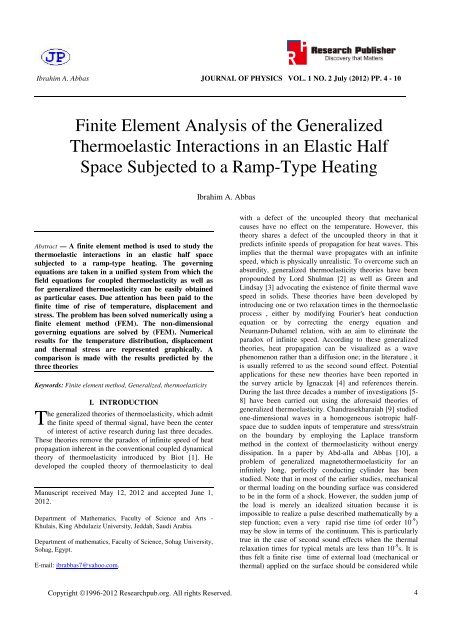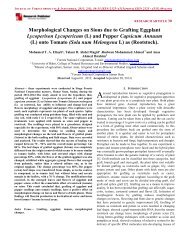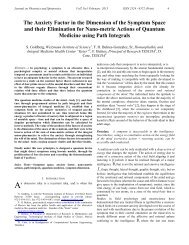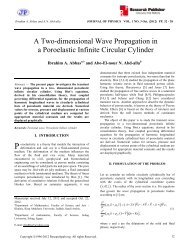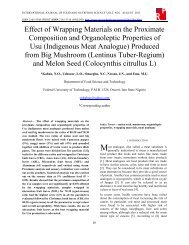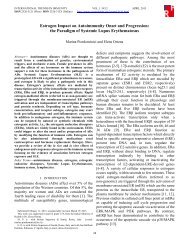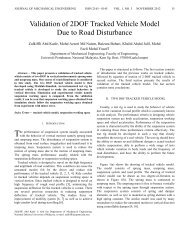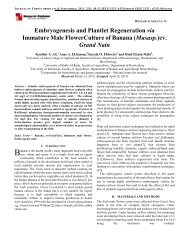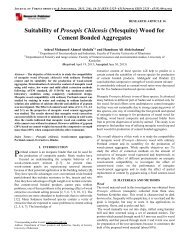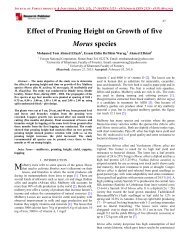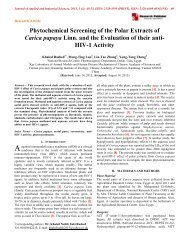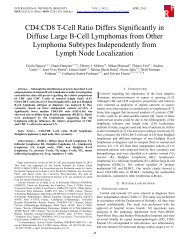Finite Element Analysis of the Generalized Thermoelastic ...
Finite Element Analysis of the Generalized Thermoelastic ...
Finite Element Analysis of the Generalized Thermoelastic ...
- No tags were found...
You also want an ePaper? Increase the reach of your titles
YUMPU automatically turns print PDFs into web optimized ePapers that Google loves.
Ibrahim A. Abbas JOURNAL OF PHYSICS VOL. 1 NO. 2 July (2012) PP. 4 - 10<strong>Finite</strong> <strong>Element</strong> <strong>Analysis</strong> <strong>of</strong> <strong>the</strong> <strong>Generalized</strong><strong>Thermoelastic</strong> Interactions in an Elastic HalfSpace Subjected to a Ramp-Type HeatingIbrahim A. AbbasAbstract — A finite element method is used to study <strong>the</strong><strong>the</strong>rmoelastic interactions in an elastic half spacesubjected to a ramp-type heating. The governingequations are taken in a unified system from which <strong>the</strong>field equations for coupled <strong>the</strong>rmoelasticity as well asfor generalized <strong>the</strong>rmoelasticity can be easily obtainedas particular cases. Due attention has been paid to <strong>the</strong>finite time <strong>of</strong> rise <strong>of</strong> temperature, displacement andstress. The problem has been solved numerically using afinite element method (FEM). The non-dimensionalgoverning equations are solved by (FEM). Numericalresults for <strong>the</strong> temperature distribution, displacementand <strong>the</strong>rmal stress are represented graphically. Acomparison is made with <strong>the</strong> results predicted by <strong>the</strong>three <strong>the</strong>oriesKeywords: <strong>Finite</strong> element method, <strong>Generalized</strong>, <strong>the</strong>rmoelasticityTI. INTRODUCTIONhe generalized <strong>the</strong>ories <strong>of</strong> <strong>the</strong>rmoelasticity, which admit<strong>the</strong> finite speed <strong>of</strong> <strong>the</strong>rmal signal, have been <strong>the</strong> center<strong>of</strong> interest <strong>of</strong> active research during last three decades.These <strong>the</strong>ories remove <strong>the</strong> paradox <strong>of</strong> infinite speed <strong>of</strong> heatpropagation inherent in <strong>the</strong> conventional coupled dynamical<strong>the</strong>ory <strong>of</strong> <strong>the</strong>rmoelasticity introduced by Biot [1]. Hedeveloped <strong>the</strong> coupled <strong>the</strong>ory <strong>of</strong> <strong>the</strong>rmoelasticity to dealManuscript received May 12, 2012 and accepted June 1,2012.Department <strong>of</strong> Ma<strong>the</strong>matics, Faculty <strong>of</strong> Science and Arts -Khulais, King Abdulaziz University, Jeddah, Saudi Arabia.Department <strong>of</strong> ma<strong>the</strong>matics, Faculty <strong>of</strong> Science, Sohag University,Sohag, Egypt.E-mail: ibrabbas7@yahoo.com.with a defect <strong>of</strong> <strong>the</strong> uncoupled <strong>the</strong>ory that mechanicalcauses have no effect on <strong>the</strong> temperature. However, this<strong>the</strong>ory shares a defect <strong>of</strong> <strong>the</strong> uncoupled <strong>the</strong>ory in that itpredicts infinite speeds <strong>of</strong> propagation for heat waves. Thisimplies that <strong>the</strong> <strong>the</strong>rmal wave propagates with an infinitespeed, which is physically unrealistic. To overcome such anabsurdity, generalized <strong>the</strong>rmoelasticity <strong>the</strong>ories have beenpropounded by Lord Shulman [2] as well as Green andLindsay [3] advocating <strong>the</strong> existence <strong>of</strong> finite <strong>the</strong>rmal wavespeed in solids. These <strong>the</strong>ories have been developed byintroducing one or two relaxation times in <strong>the</strong> <strong>the</strong>rmoelasticprocess , ei<strong>the</strong>r by modifying Fourier's heat conductionequation or by correcting <strong>the</strong> energy equation andNeumann-Duhamel relation, with an aim to eliminate <strong>the</strong>paradox <strong>of</strong> infinite speed. According to <strong>the</strong>se generalized<strong>the</strong>ories, heat propagation can be visualized as a wavephenomenon ra<strong>the</strong>r than a diffusion one; in <strong>the</strong> literature , itis usually referred to as <strong>the</strong> second sound effect. Potentialapplications for <strong>the</strong>se new <strong>the</strong>ories have been reported in<strong>the</strong> survey article by Ignaczak [4] and references <strong>the</strong>rein.During <strong>the</strong> last three decades a number <strong>of</strong> investigations [5-8] have been carried out using <strong>the</strong> aforesaid <strong>the</strong>ories <strong>of</strong>generalized <strong>the</strong>rmoelasticity. Chandrasekharaiah [9] studiedone-dimensional waves in a homogeneous isotropic halfspacedue to sudden inputs <strong>of</strong> temperature and stress/strainon <strong>the</strong> boundary by employing <strong>the</strong> Laplace transformmethod in <strong>the</strong> context <strong>of</strong> <strong>the</strong>rmoelasticity without energydissipation. In a paper by Abd-alla and Abbas [10], aproblem <strong>of</strong> generalized magneto<strong>the</strong>rmoelasticity for aninfinitely long, perfectly conducting cylinder has beenstudied. Note that in most <strong>of</strong> <strong>the</strong> earlier studies, mechanicalor <strong>the</strong>rmal loading on <strong>the</strong> bounding surface was consideredto be in <strong>the</strong> form <strong>of</strong> a shock. However, <strong>the</strong> sudden jump <strong>of</strong><strong>the</strong> load is merely an idealized situation because it isimpossible to realize a pulse described ma<strong>the</strong>matically by astep function; even a very rapid rise time (<strong>of</strong> order 10 -9 )may be slow in terms <strong>of</strong> <strong>the</strong> continuum. This is particularlytrue in <strong>the</strong> case <strong>of</strong> second sound effects when <strong>the</strong> <strong>the</strong>rmalrelaxation times for typical metals are less than 10 -9 s. It isthus felt a finite rise time <strong>of</strong> external load (mechanical or<strong>the</strong>rmal) applied on <strong>the</strong> surface should be considered whileCopyright ©1996-2012 Researchpub.org. All rights Reserved. 4
Ibrahim A. Abbas JOURNAL OF PHYSICS VOL. 1 NO. 2 July (2012) PP. 4 - 10( )( x )∂u x,0 ∂θ,0u ( x,0)= = 0, θ ( x,0)= = 0,∂t∂t⎧ 0 t ≤ 0⎪ tσ ( 0, t) = 0, θ ( 0, t) = ⎨θ1 0 < t ≤ t0⎪ t0⎪⎩ θ1 t > t0III. FINITE ELEMENT METHOD(11)(12)In order to investigate <strong>the</strong> <strong>the</strong>rmoelastic interactions inan elastic half space subjected to a ramp-type heating, <strong>the</strong>(FEM) [19-20] is adopted due to its flexibility in modelinglayered structures and its capability in obtaining full fieldnumerical solution. The governing equations (8) and (9) arecoupled with initial and boundary conditions (10) and (11).The numerical values <strong>of</strong> <strong>the</strong> dependent variables likedisplacement u and <strong>the</strong> temperature θ are obtained at <strong>the</strong>interesting points which are called degrees <strong>of</strong> freedom. Theweak formulations <strong>of</strong> <strong>the</strong> non-dimensional governingequations are derived. The set <strong>of</strong> independent test functionsto consist <strong>of</strong> <strong>the</strong> displacement δ u and <strong>the</strong> temperatureδθ is prescribed. The governing equations are multipliedby independent weighting functions and <strong>the</strong>n are integratedover <strong>the</strong> spatial domain with <strong>the</strong> boundary. Applyingintegration by parts and making use <strong>of</strong> <strong>the</strong> divergence<strong>the</strong>orem reduce <strong>the</strong> order <strong>of</strong> <strong>the</strong> spatial derivatives andallows for <strong>the</strong> application <strong>of</strong> <strong>the</strong> boundary conditions. Thesame shape functions are defined piecewise on <strong>the</strong> elements.Using <strong>the</strong> Galerkin procedure, <strong>the</strong> unknown fields u and θand <strong>the</strong> corresponding weighting functions areapproximated by <strong>the</strong> same shape functions. The last steptowards <strong>the</strong> finite element discretization is to choose <strong>the</strong>element type and <strong>the</strong> associated shape functions. On <strong>the</strong>o<strong>the</strong>r hand, <strong>the</strong> time derivatives <strong>of</strong> <strong>the</strong> unknown variableshave to be determined by Newmark time integration method[15].In particular, <strong>the</strong> equation <strong>of</strong> motion become2∂δu ⎡∂u ⎛ ∂θ⎞⎤∂ u∫ − β1 ⎜θ+ t1 ⎟ dx + δu dx =2∂x ⎢∂x ∂t ⎥ ∫⎣ ⎝ ⎠⎦∂t(13)Γ⎡∂u⎛δu⎢− β ⎜θ+⎣∂x⎝The energy equation has <strong>the</strong> form⎡Γ∂θ⎞⎤⎟∂t⎥⎠⎦1t1 .−⎛+ nt⎞⎤dx +⎛+ t⎞dx =⎝ ⎠⎦⎝ ⎠2 2∂δθ ∂θ ∂u∂ u∂θ ∂ θ∫ ⎢ β2 ⎜ 2δθ2 ⎟⎥∫ ⎜ 2 2 ⎟Γ ∂x ∂x ∂t ∂t Γ ∂t ∂t⎣⎡∂θ⎛ ∂u∂ u ⎞⎤δθ ⎢ − β ⎜ + ⎟⎥⎣ ∂x ⎝ ∂t ∂t⎠⎦Γ22nt2 .2Γ(14)IV. NUMERICAL RESULTS AND DISCUSSIONIn order to illustrate <strong>the</strong> problem, <strong>the</strong> copper materialwas chosen for purposes <strong>of</strong> numerical evaluations. Thephysical data which given as [15]10 1 2 10 1 2λ = 7.76× 10 ( kg)( m) − ( s) − , µ = 3.86×10 ( kg)( m) − ( s) − ,ρ = = ×3 −3 −6 −18.954x10 ( kg)( m) , αt17.8 10 ( K) .2 −1 −3( )T0 = 300 K , K = 3.86×10 ( kg)( m)( K) ( s) ,c = × m K se2 2 −1 −23.831 10 ( ) ( ) ( ) ,Before going to <strong>the</strong> analysis <strong>the</strong> grid independence test hasbeen conducted and <strong>the</strong> results are presented in table 1. Thegrid size has been refined and consequently <strong>the</strong> values <strong>of</strong>different parameters as observed from table 1 get stabilized.Fur<strong>the</strong>r refinement <strong>of</strong> mesh size over 5000 elements doesnot change <strong>the</strong> values considerably, which is <strong>the</strong>reforeaccepted as <strong>the</strong> grid size for computing purposeTable 1. Grid independent test ( ( t = 0.3, t = 0.4, x = 1.0)MeshsizeθCD LS GLu × 10−2−5× 10θ−2−5× 10u × 100θ−2× 10−5u × 1050 5.554107 1.370979 6.395838 8.985454 6.445057 6.672534100 5.559483 1.373254 6.566698 9.419929 6.615257 6.8633691000 5.561257 1.374003 6.622675 9.561751 6.671027 6.9258264000 5.561274 1.374011 6.623204 9.563090 6.671555 6.9264165000 5.561274 1.374011 6.623216 9.563123 6.671567 6.926430The field quantities, temperature, displacement and stressdepend not only on <strong>the</strong> time t and space x, but also depend onrise-time parameter t0and on <strong>the</strong>rmal relaxation timeparameters t 1, t 2and n. It has been observed that in all three<strong>the</strong>ories <strong>of</strong> CD, LS and GL, <strong>the</strong> finite rise-time parameter hasa significant effect on <strong>the</strong> temperature quantities. Here all <strong>the</strong>variables/parameters are taken in nondimensional forms. Theresults for temperature, displacement and stress has beencarried out by taking θ₁=1. Figures 1, 2 and 3 exhibit <strong>the</strong>variation <strong>of</strong> <strong>the</strong> temperature, displacement and stress withspace x for <strong>the</strong> classical dynamical coupled <strong>the</strong>ory CD andfour different values <strong>of</strong> time t. Figures 4, 5 and 6 show <strong>the</strong>variations <strong>of</strong> <strong>the</strong> temperature, displacement and stress underLord-Shulman's <strong>the</strong>ory LS, i.e., when <strong>the</strong>re is one <strong>the</strong>rmalrelaxation time ( t2= 0.1,0.2,0.3,0.4 ) and for t0= 0.4 att=0.3. Similar results are shown on figures 7, 8 and 9 for onet = and lettingvalue <strong>of</strong> <strong>the</strong> relaxation time ( 20.1)( )t0= 0.2,0.4,0.6 for t=0.3. Figures 10, 11 and 12 display<strong>the</strong> variation <strong>of</strong> three <strong>the</strong>ories effects on <strong>the</strong> temperature,displacement and stress. In this case, one may takeCopyright ©1996-2012 Researchpub.org. All rights Reserved. 6
Ibrahim A. Abbas JOURNAL OF PHYSICS VOL. 1 NO. 2 July (2012) PP. 4 - 10( t1 = t2 = n = 0)for CD while ( t1 0, t20.1, n 1)and ( t 0.2, t 0.1, n 0)1 2= = = for LS= = = for GL. It is obvious fromfigures 1,4,7 and 10 that <strong>the</strong> temperature decreases with <strong>the</strong>increase <strong>of</strong> <strong>the</strong> space but <strong>the</strong>y increase when decreasing <strong>the</strong>relaxation times or decreasing <strong>the</strong> rise-time parameter. Nosignificant difference in <strong>the</strong> value <strong>of</strong> temperature is noticedfor <strong>the</strong> LS and GL <strong>the</strong>ories. It is obvious from figures 2,5,8and 11 that <strong>the</strong> displacement is negative at x=0 where itsmagnitude is maximum. The displacement increases from <strong>the</strong>negative value to a positive value. In <strong>the</strong> positive values, <strong>the</strong>displacement have a peak value that depends on <strong>the</strong> values <strong>of</strong><strong>the</strong> time, rise-time and relaxation times. It is obvious fromfigures 3,6,9 and 12 which gives <strong>the</strong> stress variation atdifferent instants <strong>of</strong> time with <strong>the</strong> space. Its magnitudeincreases from zero to a maximum value ( which is positivevalue for t < t and negative value for t t00> ); after thatdecreases rapidly as x increases.Fig. 2: The displacement distribution for CD at t 0= 0.4and different value <strong>of</strong> t.Fig. 3: Stress distribution for CD at t 0= 0.4and different value <strong>of</strong> t .Fig. 1. The Temperature distribution for CD at t 0= 0.4and different value <strong>of</strong> t.Fig. 4: Temperature distribution for LS at t 0= 0.4and t = 0.3 with different value <strong>of</strong> t 2.Copyright ©1996-2012 Researchpub.org. All rights Reserved. 7
Ibrahim A. Abbas JOURNAL OF PHYSICS VOL. 1 NO. 2 July (2012) PP. 4 - 10Fig. 5: The desplacement distribution for LS at t 0= 0.4and t = 0.3 with different value <strong>of</strong> t 2.Fig. 8: The desplacement distribution for LS att2= 0.1 and t = 0.3Fig. 6: Stress distribution for LS at at t 0= 0.4and t = 0.3 with different value <strong>of</strong> t 2.Fig. 9: Stress distribution for LS att2= 0.1 and t = 0.3Fig. 7: Temperature distribution for LS att2= 0.1 and t = 0.3Figure 10: The variation <strong>of</strong> temperature for three<strong>the</strong>ories at t 0= 0.2 and t = 0.3Copyright ©1996-2012 Researchpub.org. All rights Reserved. 8
Ibrahim A. Abbas JOURNAL OF PHYSICS VOL. 1 NO. 2 July (2012) PP. 4 - 10with a cavity. Forsch Ingenieurwes 71 (2007) 215-222.[18] I.A. Abbas, A. N. Abd-alla, Effects <strong>of</strong> <strong>the</strong>rmalrelaxations on <strong>the</strong>rmoelastic interactions in aninfinite orthotropic elastic medium with a cylindricalcavity, Arch. Appl. Mech. 78 (2008) 283-293.[19] J.N. Reddy, An Introduction to <strong>the</strong> finite elementmethod, second ed., McGraw-Hill, New York, 1993.[20] R.D. Cook, D.S. Malkus, M.E. Plesha, Concepts andapplications <strong>of</strong> finite element analysis, third ed.,John Wiley, New York, 1989Copyright ©1996-2012 Researchpub.org. All rights Reserved. 10


